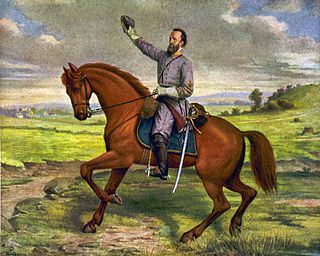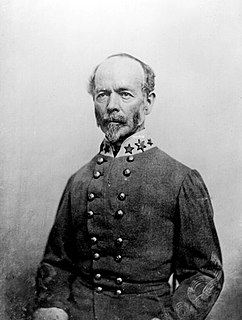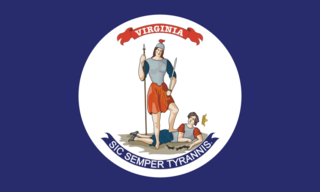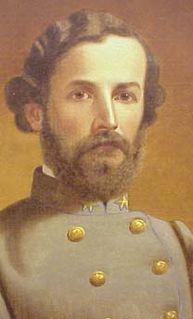The First Battle of Winchester, fought on May 25, 1862, in and around Frederick County, Virginia, and Winchester, Virginia, was a major victory in Confederate Army Maj. Gen. Thomas J. "Stonewall" Jackson's Campaign through the Shenandoah Valley during the American Civil War. Jackson enveloped the right flank of the Union Army under Maj. Gen. Nathaniel P. Banks and pursued it as it fled across the Potomac River into Maryland. Jackson's success in achieving force concentration early in the fighting allowed him to secure a more decisive victory which had escaped him in previous battles of the campaign.

Jackson's Valley campaign, also known as the Shenandoah Valley campaign of 1862, was Confederate Maj. Gen. Thomas J. "Stonewall" Jackson's spring 1862 campaign through the Shenandoah Valley in Virginia during the American Civil War. Employing audacity and rapid, unpredictable movements on interior lines, Jackson's 17,000 men marched 646 miles (1,040 km) in 48 days and won several minor battles as they successfully engaged three Union armies, preventing them from reinforcing the Union offensive against Richmond.

Turner Ashby Jr. was a Confederate cavalry commander in the American Civil War.

The First Battle of Kernstown was fought on March 23, 1862, in Frederick County and Winchester, Virginia, the opening battle of Confederate Maj. Gen. Thomas J. "Stonewall" Jackson's campaign through the Shenandoah Valley during the American Civil War.

Robert Emmett Rodes was a Confederate general in the American Civil War, and the first of Robert E. Lee's divisional commanders not trained at West Point. His division led Stonewall Jackson's devastating surprise attack at the Battle of Chancellorsville; Jackson, on his deathbed, promoted Rodes to major general. Rodes then served in the corps of Richard S. Ewell at the Battle of Gettysburg and in the Overland Campaign, before that corps was sent to the Shenandoah Valley under Jubal Early, where Rodes was killed at the Third Battle of Winchester.
The Stonewall Brigade of the Confederate Army during the American Civil War, was a famous combat unit in United States military history. It was trained and first led by General Thomas J. "Stonewall" Jackson, a professor from Virginia Military Institute (VMI). His severe training program and ascetic standards of military discipline turned enthusiastic but raw recruits into an effective military organization, which distinguished itself from the First Battle of Bull Run in 1861 to Spotsylvania Court House in 1864. Its legacy lives on in the 116th Infantry Brigade which bears the unofficial nickname "Stonewall Brigade".

Thomas Taylor Munford was an American farmer, iron, steel and mining company executive and Confederate colonel and acting brigadier general during the American Civil War.

The Army of the Shenandoah was an army of the Confederate States of America during the American Civil War; it was organized to defend the Shenandoah Valley of Virginia in the early months of the war. The army was transferred to reinforce the Confederate Army of the Potomac at the First Battle of Bull Run, which was its only major action. After the battle, the army was merged into the Army of the Potomac.

Lt. Col. Waller Tazewell Patton, was a professor, attorney, and an officer of the Confederate States Army during the American Civil War.

William Terry was a nineteenth-century politician, lawyer, teacher, slaveowner, and Confederate soldier from Virginia. The last commander of the famed Stonewall Brigade during the American Civil War also twice won election to the U.S. House of Representatives after the conflict.
The Romney Expedition was a military expedition of the Confederate States Army during the early part of the American Civil War. It is named for Romney, West Virginia, which at the time was still in the state of Virginia. The expedition was conducted in this locale from January 1 to January 24, 1862, as part of the preliminary actions of Stonewall Jackson's Valley Campaign. Confederate forces under Major General Thomas J. "Stonewall" Jackson cleared Union forces under Major General Nathaniel Banks and Brigadier General William S. Rosecrans from the lower Shenandoah Valley and surrounding Allegheny ranges, and then successfully severed the Baltimore and Ohio Railroad and the Chesapeake and Ohio Canal.

William Whedbee Kirkland was a brigadier general in the Confederate States Army during the American Civil War. He was the only former US Marine to serve as a Confederate general.

Built by Confederate Lieutenant Collier and Virginia militia with the aid of Federal prisoners, the Fort Collier redoubt guarded the north entrance of Winchester, Virginia on the east side of the Martinsburg Pike. During later Federal occupations, it was known as Battery No. 10. The fort was set on low ground, and generally offered little military advantage, except as a guard post for the pike. LtGen Jubal Early used it as part of his defensive works in the Third Battle of Winchester.
The following Union Army units and commanders fought in the Battle of Opequon in the American Civil War. The Confederate order of battle is listed separately. The battle was fought on September 19, 1864 near Winchester, Virginia, and Opequon Creek. The battle is also known as the Third Battle of Winchester and the Battle of Opequon Creek.

The 4th Virginia Volunteer Infantry Regiment was an infantry regiment raised in southwestern Virginia for service in the Confederate States Army during the American Civil War. It fought in the Stonewall Brigade, mostly with the Army of Northern Virginia. Though it suffered heavy losses, two surviving officers resumed political careers after the conflict and won election to the U.S. House of Representatives, and several more served in the Virginia General Assembly.

Colonel George Patton Sr. was a Confederate colonel during the American Civil War. He was the grandfather of World War II general George S. Patton. George Patton was also the great-grandfather of Major General George Patton IV, who died in 2004.
William Henry Harman was a brigadier general in the Virginia militia and colonel in the Confederate States Army during the American Civil War, who was killed in action during the Battle of Waynesboro, Virginia, on March 2, 1865.

The Oak Grove Cemetery, formerly known as the Stonewall Jackson Memorial Cemetery and the Presbyterian Cemetery, is located on South Main Street in downtown Lexington, Virginia, less than a mile from the campus of the Virginia Military Institute. The cemetery was named after Stonewall Jackson, who was buried here in 1863. Also buried here are 144 Confederate veterans, two Governors of Virginia, and Margaret Junkin Preston, the "Poet Laureate of the Confederacy".
The following Confederate States Army units and commanders fought in the Battle of Opequon on September 19, 1864. The Union order of battle is listed separately. The battle was fought on September 19, 1864 near Winchester, Virginia, and Opequon Creek. The battle is also known as the Third Battle of Winchester and the Battle of Opequon Creek.
The Action at Abraham's Creek was an engagement on September 13, 1864 between Union Army and Confederate States Army forces during a Union reconnaissance in force toward Winchester, Virginia. The action occurred during skirmishing, maneuvering and scouting before the Third Battle of Winchester on September 19, 1864 in the Valley Campaigns of 1864 during the American Civil War. The Union force successfully completed the mission and captured about 173 Confederate prisoners.













